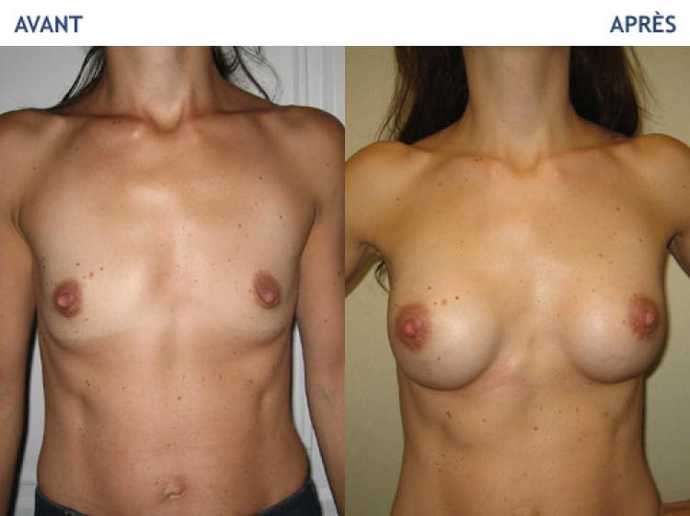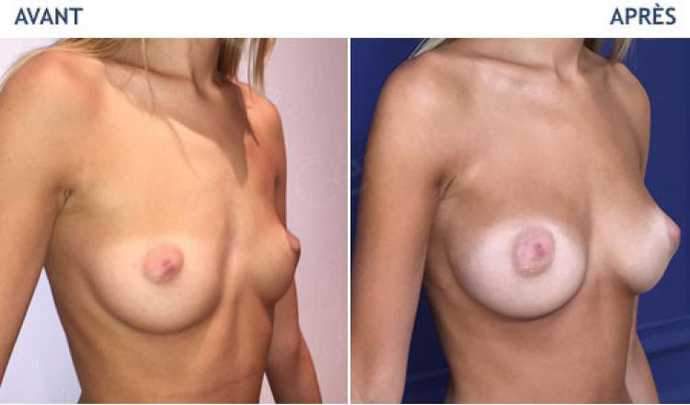Body image is important for many women. This includes the appearance of breasts. Breast augmentation surgery with implants should enhance the shape and size of breasts with a natural result. Breast implants are also used to restore a breast after surgery to treat cancer or malformation.
- In brief : Breast augmentation with implants
- Determine your desire as accurately as possible
- The different types of breast implants
- The shape of the implants: round or anatomical implants?
- Surgical options for breast augmentation
- Incision and scars during breast augmentation
- Follow-up after a breast augmentation with implants
- Before and after
In brief : Breast augmentation with implants
- Result: Natural after a few days, final between 6 months and one year
- Anesthesia: General with laryngeal mask
- Pain: between 2 and 4/10
- Scars: Discrete, hidden in the submammary fold
- Recovery: Between 3 and 7 days
- Resuming sport activities: progressive from 3 weeks
- Duration of the surgery: 1h00
- Hospitalization: Day Hospitalization
Determine your desire as accurately as possible
Recent studies have shown not only an important satisfaction of the patients on the esthetic aspect of their breast but also an improvement on their quality of life, on their social, personal and sexual relations.
The principle of a breast augmentation is to introduce a flexible implant via an incision. This will create the missing volume. Breast implants come in a variety of sizes, shapes, textures and profiles to achieve a natural result that meets the patient's desire.
In order for a breast augmentation procedure to be completely successful and the risks to be as limited as possible, the surgeon must:
- Determine the patient's desire as accurately as possible
- Perfectly analyze the anatomy of the patient
- Ensure compatibility of desire and anatomy
Define the patient's desire as precisely as possible
A breast augmentation is not about making "new breasts" but about creating the breasts that corresponds to your anatomy and your desire. Whether it is a breast that has not developed sufficiently during adolescence, breast aplasia (total absence of mammary gland) or amastasia (absence of gland and presence of a nipple very poorly developed), a breast that was partially lost during pregnancy, a breast augmentation must put the body of the patient in accordance with the way she perceives herself.
During the preoperative consultation, the surgeon determine the patient's desire as precisely as possible. For this, he can resort to the examination of photographs or the installation of "sizers" (bra which allows the placement of test implants).
Perfectly analyze the anatomy of the patient
The size of the cup is not an accurate measure or a medical term that allows to precisely define the size of the breast. Moreover, the size of the cup is very variable from one bra to another. The size of the implant is not a way to define precisely what the patient wants as the same implant does not achieve an identical result in two patients with anatomy, in essence, different.
During the consultation, the surgeon uses different measurement systems to describe the appearance of the breast: shape and size of the breasts, proportion of the silhouette, shape of the chest, elasticity, density and thickness of the mammary gland and the skin. An examination of the patient's anatomy allows the surgeon to define the final shape of the desired breasts.
Ensuring compatibility of desire and anatomy
The surgeon must ensure that the desire and the initial anatomy of the patient are compatible to achieve a result that meets her expectations with the fastest recovery possible.
The role of the surgeon is to help the patient understand the characteristics of her body and the options that are best suited to achieve the desired result:
- pathways (axillary, periareolar, trans-areolar, peri-mammary or sub-mammary scar),
- the different positions of the implant (in front of or behind the muscle, Dual Plan position),
- the shape of the implant(round, flat or anatomical) and the filling (silicone or physiological saline) of the implants.
Dr. Kron uses a 3D digital photography tool (Vectra XT) that allows a patient who wishes to perform a breast augmentation by implants to preview the result according to the type of implants (round, anatomical) and their volume.
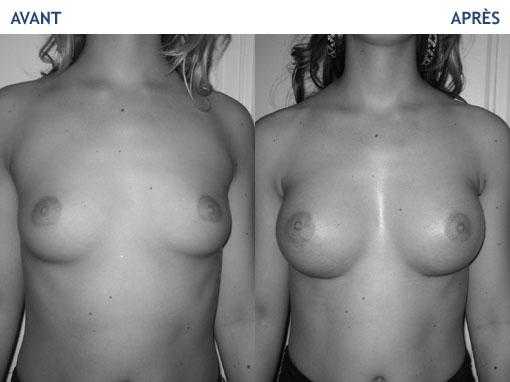
Is breast augmentation with implants the right procedure for you?
- Have you measured the benefits of this intervention?
- Did you make that decision after a thoughtful reflection?
- Do you know the possible complications and consequences of such an intervention?
- Would you be willing to remove your implants temporarily or permanently if necessary?
- Are you ready to assume the financial costs of such an intervention?
If you answer yes to these questions, you can consider the intervention. If not, you can discuss with your surgeon a breast augmentation without an implant.
There is another technique for breast augmentation without the use of implants: injection of fat cells (breast lipofilling).
The different types of breast implants
If there are so many different types of implants, does it mean that none is universal?
The experience of the plastic surgeon allows him to propose the options that will adapt in a realistic and aesthetic way to the request of the patients. The choice of implants must be made according to the aesthetic result desired by the patient, her initial anatomy and compromises that she is ready to accept. The surgeon will advise the patient by assessing the best possible benefits and risks of each solution.
Criteria for choosing breast implants
The choice of implants adapted to a patient must take into account three criteria that may affect the naturalness of breast augmentation:
- Filling rate of the implant. The less the implant is filled, the more flexible it will be, but the greater the risk of creases on the wall.
- Thickness of the implant wall. The thicker the wall, the longer the implant 'lasts' and the less the patient runs the risk of subsequent interventions. However, a thick implant may be more likely to have a thinner implant.
- Thickness of the tissue covering the implant. The thicker the tissue, the more the breast will "protect" the implant and prevent it from feeling. The finer the tissue, the more likely it is to feel some parts of the implant, especially if a large breast volume is desired. It should be known that the thickness of the tissue is a criterion much more important than the thickness of the wall of the prosthesis.
The thickness of your tissues is something that can not be changed. If the risk of feeling your implant is unacceptable, you can discuss surgeries with your surgeon that do not use implants such as Breast Lipostructure.
Implants filling: silicone or physiological saline?
The silicone implants currently used in France are filled with a cohesive gel that does not "run" if the wall breaks. Because of their consistency, there is no risk of migration of the silicone in case of rupture of the implant.
Physiological saline is an isotonic solution of sodium chloride (salt water constituting 70% of the human body). In case of rupture of an implant in physiological serum, it will be absorbed safely in the body. This risk is greater if there are wrinkles on the implant. To avoid creases on physiological saline implants, it is often necessary to over-inflate them, which has the effect of tightening their walls. It should be noted that an over-inflated implant may accentuate an unnatural crown to the breasts, giving a "balloon" effect in both its shape and feel.
In order to limit the risk of forming a "shell" or the risk rotation of the implant, Dr. Kron mostly uses polyurethane breast implants.
The polyurethane foam surrounding the prosthesis allows an active healing process. In place of the formation of a single capsule that has significant contraction potential, polyurethane foam promotes the formation of many micro-encapsulations of the foam, which neutralizes the risk of contracture.
Polyurethane implants significantly reduce the risk of displacement or rotation of the implant following the intervention. The adhesion to the fabric is major. Dr. Cedric Kron's experience has allowed him to eliminate the risk of implant rotation, problematic for anatomical implants.
The shape of the implants: round or anatomical implants?
Almost all current round implants are more or less underfilled relative to the total volume of their envelope to avoid a rounded shape too bouncy and / or a lack of flexibility. Whatever the type of filling of the implant (silicone or physiological saline), the risks of folds on the wall and rupture of the envelope vary according to the degree of filling:
- The more flexible an implant, the more it will need to be covered by a large tissue thickness to limit the risk of rupture of the envelope.
- The more an implant is filled and the thicker its wall (to prevent the risk of folds and rupture), the more the breast can appear excessively convex. This phenomenon appears all the more frequently in the case of a chest of small volume and / or particularly fine tissue.
Round shaped breast implant
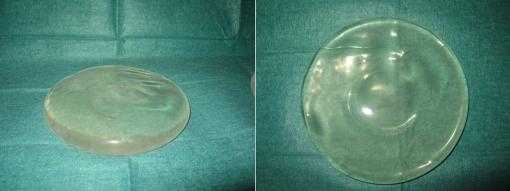
In order to limit a less natural curved aspect, a round implant must be of moderate or low projection and often a little more flexible (thinner wall, inferior filling rate). By being more flexible, a round implant has however more risk of seeing its upper part that "collapse" and wrinkles, especially since there are few tissues that cover it.
Anatomic breast implants
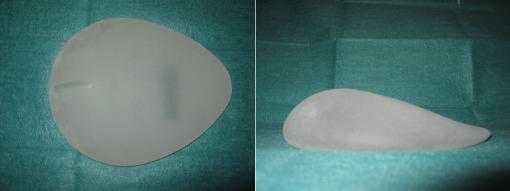
An anatomic implant has the shape of a drop of water: more filled in the lower part, more tapered in the upper part. It naturally has the shape of a breast in a vertical position. Because of this shape, an anatomical implant can have a high filling rate to prevent wall creases while maintaining an optimal aesthetic shape.
Unlike round implants, an anatomically shaped implant can be well filled without producing an excessive bulging effect in the upper breast. Choosing an anatomical implant is therefore a good compromise between a high filling rate and the preservation of the natural form of the breast.
An anatomical implant may be more stable over time. Allowing for a good filling rate of the upper pole while keeping its vertical height, there is risk of "collapse". Nevertheless, it may be less flexible than a less filled implant or an implant with a thinner wall.
Smooth or textured implants?
Textured implants have been proposed by laboratories as an alternative to smooth implants to reduce the risk of capsular contracture ("shell") around the prosthesis. The "textured" implants are supposed to prevent the organization of fibers that form the capsule around the implant. To date, scientific studies published on the subject have not proved their effectiveness irrefutably.
If the choice of the type of prosthesis is on an anatomical form, their wall must be textured. By allowing the implant to adhere to surrounding tissue, a textured wall reduces the chance of an implant "spinning" in the breast.
Textured implants do not necessarily feel more in the breast than smooth implants - which may have more or less thick walls. In all cases, it is the thickness of the tissue that covers the implant that is crucial in the fact of feeling it.
The risk of wrinkling is not necessarily greater in the case of a textured wall implant to the extent that the factors that can promote the presence of folds do not affect the texture of the implants. Indeed, the folds are caused by the degree of filling of the implant, the thickness of the tissue and the degree of traction exerted on the prosthesis. On the other hand, if an implant creases while adhering to tissue, it is more likely to transmit its folds within an implant that does not adhere to it.
Some laboratories guarantee their implants against possible defects for several years, but this is not a sufficient criterion of choice. Dr. Kron uses only implants for which there is a proven medical consensus.
Only exchanges with a plastic surgeon can allow you to arbitrate between the different possible choices. Choosing a type of implant is always accepting a certain compromise.
Surgical options for breast augmentation
There is no ideal and iterative surgical option for all women. The specificities of each patient, both in their wishes, and in their initial anatomy must determine the choice of the surgical option.
In the case of breast augmentation by implants, there are three ways to position the prosthesis, each of which has its advantages and disadvantages. It is up to the surgeon to counsel the patient and explain the options that will maximize benefits and minimize risk.
In front of the muscle:
The retro-pectoral or retro-muscular technique has the characteristics of using the muscle to cover all or part of the implant.
Advantages:
- This technique allows precise control of the shape of the breasts, including the distance between the two breasts.
- It also allows precise control of the filling of the upper pole of the breast, in particular in the inner part (middle of the neckline).
- The implant can not move to the side because of the pressure exerted by the muscle (which could widen the distance between the breasts)
- The shape of the breast can not be changed during the contraction of the muscle.
Disadvantages:
- For particularly thin women, the prosthesis will not necessarily be completely covered by the muscle. It is then possible to see the periphery of the implant.
- This position makes the analysis of mammograms more complex: the gland and the implant are less dissociated than in the retro-pectoral position.
Behind the muscle:
The prepectoral or retroglandular technique has the characteristic of placing the prosthesis between the muscle and the mammary gland.
Advantages:
- This technique limits the risk of seeing the contours of the implant, especially on the upper part of the breast.
- This position limits the risk of capsular contracture ("shell"), especially with silicone implants.
- The majority of radiologists consider that mammography analysis is simplified when the muscle is partially interposed between the gland and the implant.
Disadvantages:
- The breast is more deformed during the contraction of the muscle. It should be known that this phenomenon also appears in some women who do not wear implants, especially for small breasts.
- There is a risk of progressive displacement of the implant over time, which tends to widen the distance between the two breasts.
- The control of the filling of the upper part of the breast is less precise than in the case of a position "in front of the muscle"
In front of or behind the muscle, how to choose?
The short-term aesthetic result may be better when the implant is placed in front of the muscle but, in thin women in particular, placing it behind the muscle can often cover the implant more perennially.
You can get a first idea of the technique that best fits your anatomy by measuring the tissue coverage of the upper part of your breasts. For this, pinch your skin over your breast.
- If the width you get is less than 2 cm, it is probably best to place the implant behind the muscle to ensure a good tissue coverage of it. This solution makes it possible in particular to limit the risk of seeing the contours of the implant through the skin.
- If you have a tissue coverage greater than 2 cm in width, both techniques are possible. You can weigh the pros and cons of each and choose according to your preferences and your surgeon's recommendations.
Dual Plan
The Dual Plan technique consists of taking off the muscle completely at the level of the breast groove as well as in front of and behind it so as to make it more flexible when positioning the implant. The implant is placed behind the muscle in the upper part of the breast and behind the gland in the lower part. As the muscle is better "freed" and more flexible, the prosthesis is better positioned without compression and the mammary gland is better "spread" around the implant and the muscle.
This technique has the advantage of retaining the advantages of a retro-muscular prosthesis and recovering those of a retro-glandular position while limiting the disadvantages of these two techniques:
- Less risk of progressive displacement of the prosthesis on the side with time,
- Allows a more precise control of the filling of the upper part of the breast,
- Limit postoperative pain,
- Helps correct a limited breast ptosis without additional scars.
Dr. Kron adapted the Dual Plan technique to his experience in order to obtain a lasting and natural result with painful postoperative effects. Its results were presented at the International Scientific Congress.
Today, most of the breast augmentation he performs uses the Dual Plan position.
- Surgical options for breast augmentation with prostheses
- Surgical options for breast augmentation with prostheses
- In the case of breast augmentation by prostheses, there are three ways to position the prosthesis which each have their advantages and disadvantages: above in front of and behind the muscle.
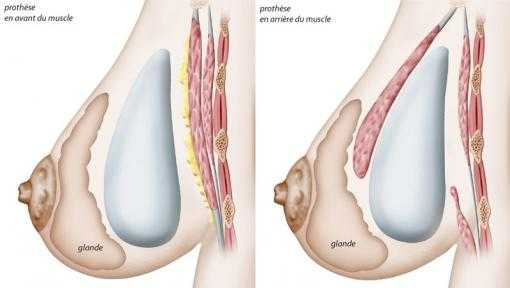
In the case of breast augmentation by prostheses, there are three ways to position the prosthesis which each have their advantages and disadvantages: above in front of and behind the muscle.
Incision and scars during breast augmentation
There are three types of incisions that each have their advantages and disadvantages: incision under the breast, at the areola or under the arm. A surgeon who has experience with all types of incisions will be able to offer the patient the best options based on their anatomy and wishes.
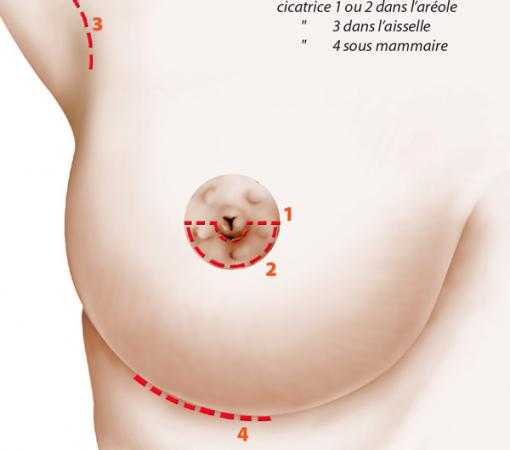
The transareolar or periareolar incision (1) or sub-nipple (2)
The periareolar incision (around the areola of the breast) or transareolar and sub-nipple (through the areola and under the nipple) has the advantage of a location that heals particularly well. To consider such an incision, it is important that the areola is large enough to allow the establishment of the implant with sufficient control for the surgeon.
Axillary incision (3)
The axillary incision (under the arm) has the advantage of being placed in a generally not very visible area. This type of incision may seem attractive for a first increase but it should be known that in case of recovery (for implant change or following complications), an incision at another location may be necessary. It is also the position that offers the least degree of control during the intervention. The surgeon can then use specific instrumentation (endoscope, cold light) to maintain a good degree of control.
Breast incision (4)
The sub-mammary incision, that is to say at the level of the future groove of the breast, is today the type of incision most used by plastic surgeons (according to published scientific series). Among the different incisions possible, it is she who offers the best degree of control to the surgeon during the procedure. On the other hand, it generates a scar in the submammary groove.
The type of incision is determined by the surgeon taking into account the desire of the patient.
Follow-up after a breast augmentation with implants
As mentioned above, three types of incisions can be considered during a breast augmentation with implants: under the breast, at the areola or under the arm. The scars induced by the intervention are therefore different according to the type of incision practiced.
The procedure, lasting between 1 hour and 1 hour and 30 minutes, is generally performed under general anesthesia. This is supplemented by long-term local anesthesia to limit the importance of general anesthesia and postoperative pain.
Generally, Dr. Kron does not use a drain or painful compressive bandage. This allows the patient to see the result when she wakes up, before the edema has time to settle.
The follow-up is simple in the majority of cases: the gene is moderate and normal activities can resume after a few days. 80% of patients can raise their arms above the head, shower and wash their hair without help from the day or the day after surgery. The exit is usually the day after surgery. The wearing of a support bra is not mandatory, except in certain cases (it will then be worn day and night for 15 days).
At the end of the procedure, Dr. Kron will apply a "special" bandage, resistant to water and microbes, allowing you to shower every day without special care or intervention of a nurse. This bandage does not prevent healing or gaseous exchange of the skin to the outside, allowing a normal healing process. This bandage will be changed without pain in consultation by Dr. Kron himself.
The intensity of the pain varies according to each person. Some patients no longer take painkillers the day after surgery. In general, taking analgesics during the first 4 days relieves pain while physical discomfort is observed during the first 10 days.
Convalescence after breast augmentation with implants
In the first days, it is normal for the breasts to appear swollen, too big or too firm. It is possible that the breasts are not alike (difference in size and shape) and that their shape changes every day. Breast tenderness is temporarily altered (they may seem sleepy or, on the contrary, too sensitive). The usual sensitivity of the breasts is found, at the latest, after a few weeks.
These are relatively common post-operative effects that should not worry. The patient should keep in mind that the outcome of the procedure can only really be assessed after one to three months. The breasts do not take their final form until three to six months after the procedure. The scars gradually fade, disappearing between six months and a year and a half after the operation.
Some postoperative symptoms should alert the patient. This one will have to contact surgeon if it finds:
- A fever over 38.5 °, possibly accompanied by chills
- One breast that becomes much larger than the other
- A breast that becomes much more bruised than the other
- Special pain or redness in one area of the chest
- A flow at the level of the scar.
In order for the postoperative recovery to proceed as smoothly as possible, it is imperative to follow exactly the instructions given by the surgeon.
Possible risks following breast augmentation with implants:
Since this is a surgical procedure, all the risks of a surgical procedure can occur during breast augmentation (see "Risks in Plastic Surgery").
Smoking increases the risk of surgical complications of any surgery. Stopping smoking 6-8 weeks before the procedure eliminates this additional risk. If you smoke, talk to your doctor, surgeon, and anesthesiologist, or call Tobacco-Info-Service at 3989 to help reduce risk and put the odds on your side.
The risk of "shell" is rare, but it must be understood and its risk accepted by the patient before the intervention. This is a scar retraction around the prosthesis forming a fibrous layer. Sometimes it can be remedied by massage or retouching. In other cases, removal of the prosthesis may be necessary.
Dr. Kron has never used PIP brand implants in cosmetic breast augmentation.
Before and after: breast augmentation with implants
